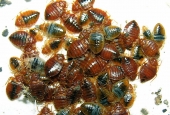Bed bugs are oval, flattened, brown, and wingless insects. They vary in size depending on age. A newly hatched bed bug is hard to see because it is semi-transparent, light tan in color, and only the size of a poppy seed. It is easier to see the adult bed bugs because they are about the size of an apple seed (1/4 inch) and dark brown in color.
Bed bugs need a blood meal to grow and lay eggs. A female bed bug may lay 5-7 eggs per week and are capable of laying 200 -500 eggs in her lifetime. Eggs take approximately 10 days to hatch. The newly hatched bed bugs are called nymphs and quickly search for their first blood meal. The nymphs go through 5 stages over a 2-4 month period and each stage needs a blood meal for development.
Bed bugs are most active at night and hide during the day in cracks and crevices. While feeding, they leave blood stains on bedsheets, mattresses, or clothing. These blood spots are classic signs of a potential bed bug infestation. They also leave fecal droppings and eggs within the seams and tufts of mattresses, box springs, pillows, upholstered furniture, and along baseboards.
Bed bugs are parasites that feed on the blood of people and their pets. The bite from a bed bug is painless. In some cases the bite will produce no reaction, but for others it can produce welts that are extremely itchy and may last for days or weeks. In situations where individuals do not react to the bite, or misidentify it as a mosquito bite, bed bug population can increase tremendously before the infestation is discovered.
Bed bugs are not known to transmit disease. In addition to skin rashes, bed bug infestations may aggravate respiratory conditions, and excessive scratching of a bite can lead to infection. Sleeplessness and psychological distress may occur.
Managing a bed bug infestation can be extremely difficult and challenging. Effective control requires education, cooperation, communication and prevention. Following are important preventive measures to minimize the risk of bed bug infestations:
- Never bring bed frames, mattresses, box springs or upholstered furniture found on the sidewalks into your home.
- Inspect all used or rental furniture thoroughly for bed bugs.
- When traveling, inspect the mattress, headboard, and end tables for live bed bugs and look for blood spots and droppings. Do not put your clothes in dresser drawers or luggage on the spare bed or floor. Before leaving the hotel check your suitcase and belongings carefully for live bed bugs.
- If you think you may have been exposed to bed bugs while traveling, after arriving home, wash and dry your clothes on the hottest settings, or bag your clothes and take them to the cleaners.
- Make sure all the cracks and crevices in your bedrooms are sealed with a caulking compound to prevent bed bugs entering from another room.
If you think you may have bed bugs, call the District so our Staff Biologists can perform a thorough inspection of your property.
Controlling a Bed Bug Infestation
Applying insecticides in your home or office to control a bed bug infestation should be done by a well-trained, licensed pest control professional. Infestations in multi-unit apartments, condominiums, senior centers, or nursing homes should be reported to the property owner or management immediately. Tenants should never attempt to control the bed bug problem by themselves, as it may make future treatments more difficult.
If you suspect a bed bug infestation, contact the District to make a request for service. Our Biologist will inspect your property for evidence of bed bugs. We will work with the property owner and management to provide consultation and training on bed bug control. We will provide advice in selecting the right company, and understanding the different types of treatments available for control.






